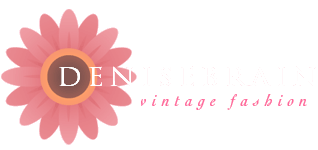 |
| photo courtesy of desktopretreat.blogspot.com |
One summer, I read the
Fairchild’s Dictionary of Textiles cover to cover (don't I know how to have fun?) and chose a collection of fabrics that seemed to come up in vintage clothing descriptions and in my observations. I didn’t, and don’t, consider myself an expert on the subject, but I love learning about fabrics.
I really
have to know fabric better all the time. I sell vintage clothing, and my buyers and I want to know what a item is made from. To know this is to tell someone whether she will be allergic, how to wash or clean the item, predict how it will take dye. It is to know how fine it is, how long it will last, how the color will hold up. It helps make certain the vintage. It gives a better sense of how it will feel when worn. Buying clothing online is hard enough, and knowing all you can about the item is just smart.
The year after I read the Fairchild’s I was a board member of the Vintage Fashion Guild, and I proposed the idea of the VFG website having a fabric resource. For many years, the
VFG Label Resource has made an inestimable contribution to vintage knowledge and interest, and the other resources (
Fur Resource and
Lingerie Guide) are also of tremendous value (heck, you should just go check out the
whole site!). Everyone thought a fabric resource was a good idea, so I got started on it.
Fast forward to 2012, and I have been working bit by bit on a fabric resource for most of five years now. Fabrics are complicated. As one article in an issue of the great American Fabrics magazine begins:
The history of textiles is the history of the world...politically, socially, economically.
So much of human history has been
interwoven with fabrics—any one fabric can take you back to ancient civilizations, or even prehistoric times. This makes many of them difficult to quickly summarize. I noted one of the fabrics in the Fairchild’s that was particularly mind-boggling for me, frisé.
frisé [free-zay’] 1. Originally the finest grade of linen made in Friesland, The Netherlands. It was strong, stout, grained, and well-bleached. 2. A French term for curled. 3. A coarse ratiné fabric that is made with slub yarns in a plain weave ( See RATINÉ 1.) 4. A looped pile fabric usually of uncut loops that may have a pattern cut into them. This term sometimes is used for TERRY CLOTH or BOUCLÉ FABRIC. 5. A coarse, stout cotton or linen fabric that is made in a plain weave with a flat, wiry texture and a pronounced rep or rib. Made in imitation of the worsted or mohair pile fabric known as FRIEZE. All fabrics listed in 1.—5. are used for upholstery. 6. A cut pile carpet of twisted yarns in solid color or of varicolored yarns.
You can see there are divergent histories here, along with terms that may not be familiar (they certainly weren’t all familiar to me). There are comments about usage, origins of the name, related fabrics. Not all fabrics have this much complexity in their definitions, but some have more.
I’m not trying to make excuses for the long time I’ve been working on this; on the contrary, when the Fabric Resource is published in mid July it will just be a start—I plan to continue working on it. I really just mean to say it is a very deep subject, with much to know. My hope is that the Fabric Resource will provide basic information about fabrics, help people searching for the name of a “mystery” fabric, help with determining fiber types, and maybe even inspire some interest in further research.
I know I’m inspired by fabrics, and I hope others are too!
Would you like one sneak peek? Just to explain, there will be a link to a definition in the resource for all the words in bold type, and a link to any related fabrics. It will be possible to click on all photos to enlarge them to 1000 x 1000 pixels.
Chinchilla cloth
Constructed like fleece, with a long
nap, chinchilla cloth is given a machine
finish which rubs the nap into
nubs. It is made of wool, wool blends, and the
warp may be cotton for strength. The town of Chinchilla, Spain is where the present fabric was first made.
Uses: Coats, hats
See also
fleece
























































